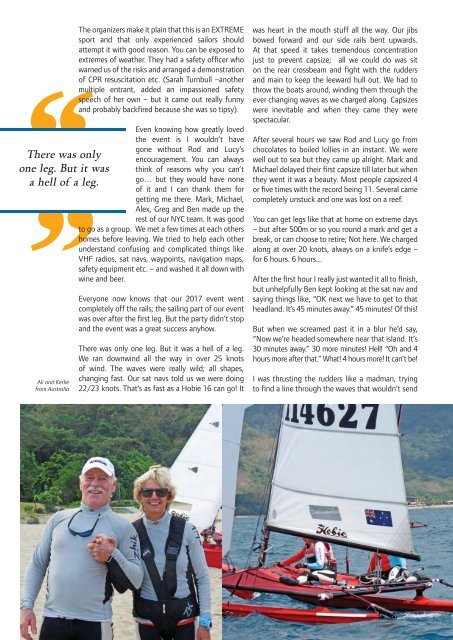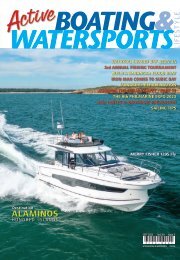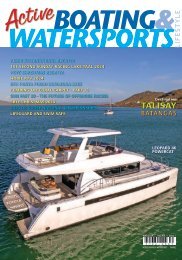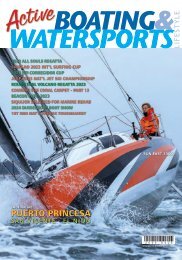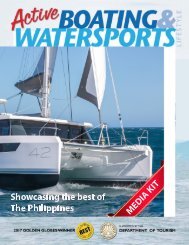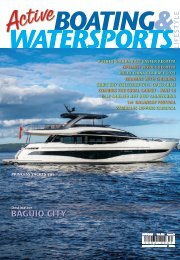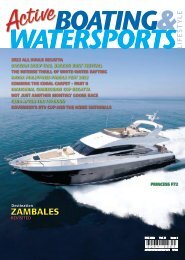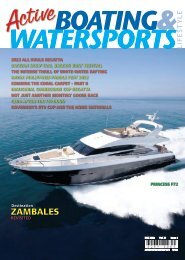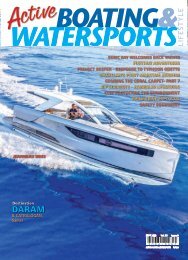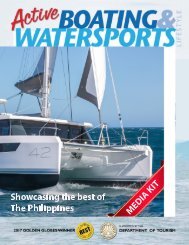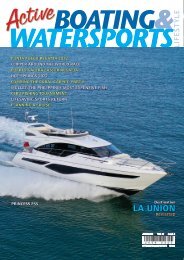ABW June 2017
Create successful ePaper yourself
Turn your PDF publications into a flip-book with our unique Google optimized e-Paper software.
Ali and Kerlie<br />
from Australia<br />
The organizers make it plain that this is an EXTREME<br />
sport and that only experienced sailors should<br />
attempt it with good reason. You can be exposed to<br />
extremes of weather. They had a safety officer who<br />
warned us of the risks and arranged a demonstration<br />
of CPR resuscitation etc. (Sarah Turnbull –another<br />
multiple entrant, added an impassioned safety<br />
speech of her own – but it came out really funny<br />
and probably backfired because she was so tipsy).<br />
Even knowing how greatly loved<br />
the event is I wouldn’t have<br />
gone without Rod and Lucy’s<br />
encouragement. You can always<br />
think of reasons why you can’t<br />
go… but they would have none<br />
of it and I can thank them for<br />
getting me there. Mark, Michael,<br />
Alex, Greg and Ben made up the<br />
rest of our NYC team. It was good<br />
to go as a group. We met a few times at each others<br />
homes before leaving. We tried to help each other<br />
understand confusing and complicated things like<br />
VHF radios, sat navs, waypoints, navigation maps,<br />
safety equipment etc. – and washed it all down with<br />
wine and beer.<br />
Everyone now knows that our <strong>2017</strong> event went<br />
completely off the rails; the sailing part of our event<br />
was over after the first leg. But the party didn’t stop<br />
and the event was a great success anyhow.<br />
There was only one leg. But it was a hell of a leg.<br />
We ran downwind all the way in over 25 knots<br />
of wind. The waves were really wild; all shapes,<br />
changing fast. Our sat navs told us we were doing<br />
22/23 knots. That’s as fast as a Hobie 16 can go! It<br />
was heart in the mouth stuff all the way. Our jibs<br />
bowed forward and our side rails bent upwards.<br />
At that speed it takes tremendous concentration<br />
just to prevent capsize; all we could do was sit<br />
on the rear crossbeam and fight with the rudders<br />
and main to keep the leeward hull out. We had to<br />
throw the boats around, winding them through the<br />
ever changing waves as we charged along. Capsizes<br />
were inevitable and when they came they were<br />
spectacular.<br />
After several hours we saw Rod and Lucy go from<br />
chocolates to boiled lollies in an instant. We were<br />
well out to sea but they came up alright. Mark and<br />
Michael delayed their first capsize till later but when<br />
they went it was a beauty. Most people capsized 4<br />
or five times with the record being 11. Several came<br />
completely unstuck and one was lost on a reef.<br />
You can get legs like that at home on extreme days<br />
– but after 500m or so you round a mark and get a<br />
break, or can choose to retire; Not here. We charged<br />
along at over 20 knots, always on a knife’s edge –<br />
for 6 hours. 6 hours...<br />
After the first hour I really just wanted it all to finish,<br />
but unhelpfully Ben kept looking at the sat nav and<br />
saying things like, “OK next we have to get to that<br />
headland. It’s 45 minutes away.” 45 minutes! Of this!<br />
But when we screamed past it in a blur he’d say,<br />
“Now we’re headed somewhere near that island. It’s<br />
30 minutes away.” 30 more minutes! Hell! “Oh and 4<br />
hours more after that.” What! 4 hours more! It can’t be!<br />
I was thrusting the rudders like a madman, trying<br />
to find a line through the waves that wouldn’t send<br />
82


